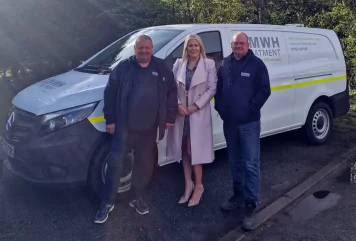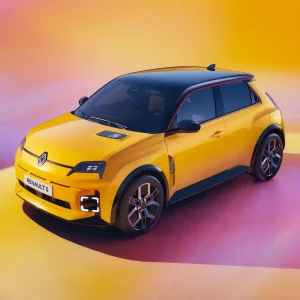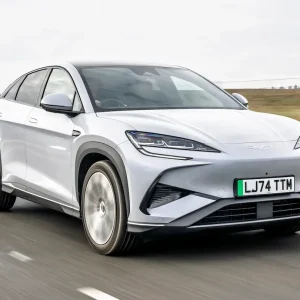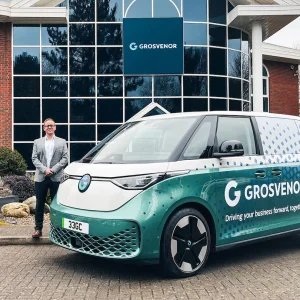
With a 205-year legacy in the water sector, MWH Treatment is dedicated to building resilient water infrastructure through the expertise of more than 1500 professionals in engineering, procurement, delivery and operations. In her role as fleet and employee benefits manager, Leah Lindsay plays a vital part in advancing this mission, ensuring seamless fleet operations and providing employees with the benefits they need to succeed and thrive.
Lindsay’s career story begins in her early twenties when, unsure of what to do after her exams, she took a summer job. Initially, she didn’t plan on sticking with it, but her passion for cars and vehicles quickly turned into a full-time career. She thrived in sales, eventually becoming the top-performing sales manager in the UK and Ireland for her company. But her curiosity didn’t stop there – after six years, she decided to transition into fleet management, a role that intrigued her from the start.
“I’d always had a love for cars,” Leah reflects. “It’s something that just came naturally to me, and when I started working with fleet managers, I knew that was the path I wanted to pursue.”
Now, with 25 years in the fleet industry, including 20 years specifically in fleet management, and 10 years with MWH Treatment, Lindsay has made significant strides in her field. Starting as a commercial vehicle fleet administrator at MWH Treatment, she worked her way up to fleet manager and later took on the added responsibility of managing employee benefits, including pensions, private medical schemes, and salary sacrifice programs.
Today, she oversees a fleet that has grown substantially over the past six years, a testament to her leadership and expertise. But for Linsday, it’s not just about managing vehicles; it’s about creating a workplace where employees are valued and supported. “It’s all about resilience,” she says. “Not just in the infrastructure we provide, but in how we support our people.”
As one of the country’s leading organisations within the water industry, Leah’s work ensures that the company’s fleet is efficiently managed, sustainable, and always ready to meet the demands of a dynamic and ever-evolving sector.
The fleet currently consists of more than 600 company cars and 140-plus LCVs, managed by Linsday and her team: “So even though I’m at management level, I’m on the ground too, dealing with the drivers directly on a day-to-day basis.”
The company consists of a diverse range of roles, from the CEO & the board through to supervisors and commissioning engineers to project managers, commercial managers and construction managers – all of whom are provided with company vehicles. They also offer a salary sacrifice option for those who qualify.
The fleet structure is tiered, with a clear grading system from level 1 to level 10, where level 10 is the highest. Alternatively, if they drive fewer than 10,000 business miles per year, they may choose to take cash and provide their own vehicle.
Additionally, about six months ago, Lindsay explains the fleet introduced a salary sacrifice scheme through Tusker, to enable employees to utilise a discounted electric vehicle, the scheme is available to all employees who have been with the company for more than three months. “We’ve had a great response so far and are now offering the same benefit to family members of our employees, provided they meet the national minimum wage criteria.”
Hitting targets, reaching goals
As a fleet manager, Leah Lindsay is committed to advancing the company’s sustainability goals, particularly as they work towards achieving net-zero carbon by 2030. With the total fleet already 71 per cent ultra-low emission vehicles, including 38 per cent zero-emission vehicles, Lindsay is now focused on helping drivers recognise the crucial role EVs play in building a greener future. “A key part of that is increasing awareness of the benefits of EVs and how they contribute to our broader sustainability objectives,” she explains.
Having driven an EV for five years without encountering the common issues often associated with electric cars – such as charging difficulties or battery degradation – Lindsay is well-positioned to challenge misconceptions. “Despite my positive experience, many drivers still have reservations, often fueled by negative press or misunderstandings. They might assume I’m just trying to sell them something to meet targets, which makes it harder to change their mindset,” she admits.
To address this, Lindsay has started organising informal “fireside chats”, where drivers can openly share their real-world EV experiences. “The aim is to help drivers understand the real-world benefits and experiences of driving electric vehicles. There’s often a divide between those in company cars and those in traditional vehicles, and bridging that gap is crucial.”
Additionally, the fleet has launched a new benefit allowing all employees – not just those with company cars – to order a home charging point through our online scheme. The company pays for the charge point upfront, and employees can pay it back over 12 months. “It’s been well-received,” Lindsay says, “and it’s a great way to support our team while also making EV ownership more accessible.”
Lindsay also emphasises the importance of confronting negative EV press directly. “There’s a lot of misinformation out there and it infuriates me, so I want to show drivers that driving an EV can be a smooth, enjoyable experience – one that aligns with our company’s sustainability goals.”
Her ultimate goal is to help drivers see the positive impact that EVs can have on both the environment and their personal driving experience, especially as the company approaches its 2030 sustainability milestones.
Looking ahead, my ambition is that we move to an electric-only fleet, this will pose some challenges and will need to be phased to overcome the issues of availability and range limitations. For vans, availability is often an issue or the range isn’t suitable, making them unfit for purpose. That’s a sticking point for us, but I am proud of us being this far ahead at this point, she adds.
Money, money, money
Five years ago, the fleet transitioned from contract hire to finance leasing with Holman, aiming to realise cost savings. However, the true impact of the switch wasn’t clear until the end of their first 48-month cycle. “When we evaluated the results of the case study, it clearly reflected the improvements we’d made,” says Lindsay. “Overall, this shift has been very positive, helping streamline our operations and better manage the fleet. It’s a significant and encouraging step forward.”
As Lindsay and her team continue to look for ways to improve, they’ve focused on navigating the major shift from ICE vehicles to fully electric ones. This transition has brought its own challenges, particularly concerning safety, given the power and instant acceleration of electric vehicles. Within the first few months of drivers switching to EVs, there was an increase in speeding and accidents. To address this, Lindsay’s team added a short video to their risk management platform for drivers transitioning to EVs. The video highlights key differences, such as more powerful braking and acceleration, to ensure drivers understand the unique driving dynamics of these vehicles.
Driver safety remains a top priority for Lindsay and her team, especially over the past 12 months, which have presented additional challenges. The fleet uses a comprehensive risk management system, which all drivers must complete. “We also offer on-road driver training for high-risk drivers and closely monitor driver miles and fatigue. We’re doing everything we can to mitigate risk,” Lindsay explains.
Currently, the fleet’s accident incident rate for 2024 stands at 1.8%, which is low compared to the industry average. “I’m really proud of that,” Lindsay says. “But what frustrates me is the rising costs of insurance and SMR. Despite our low incident rate, we’ve seen significant increases in these costs due to rising repair expenses – something we have no control over.”
From a cost perspective, Lindsay notes that it’s difficult to influence these increases. “It’s frustrating to know we’re putting in all this effort, but still facing a 30 per cent rise in insurance premiums this year.”
Lindsay says another big challenge in fleet right now is the uncertain market and vehicle availability. “While it’s exciting to see new brands entering the UK, the sustainability of this influx is a concern. Investing in a vehicle that could lose value if the manufacturer goes out of business – especially when we’re committing to it for four years – is a real worry. As much as I’d love to explore new options, it’s hard to take the risk when the market is so unpredictable,” she notes.
The rising cost of vehicles is another issue. “A few years ago, we were looking at around £25,000 for a decent vehicle, but now we’re talking about £45,000. It’s a challenge to manage costs while also meeting expectations. As much as we’d like to offer the best vehicles possible, we can’t keep increasing costs. I do hope manufacturers can find ways to reduce prices to make them more affordable for businesses.”
In terms of our fleet, MWH has 11 brands for fleet drivers to choose from, including Mercedes, BMW, Tesla, Audi, Volvo, Hyundai, Genesis, and BYD, among others. “It’s a great selection for drivers, and we’re seeing brands like Cupra growing in popularity due to their reasonable EV pricing,” says Lindsay.
Shifting gears: championing women in fleet
One of Linsday’s key goals is to encourage more women to join the fleet industry. “I’ve been working in the vehicle sector since I was 20, and back then, there were very few women in the field. Over the past 25 years, progress has been made, but not at the rate it should have been. I’d love to become an advocate for women entering the industry and help create a platform for them to thrive.”
Last year, Lindsay took part in a course with the Association of Professional Fleet Managers called ‘Women’s Voices in Fleet,’ and describes it as one of the most inspiring experiences she has ever had. “There were 12 women in the course, ranging from those my age to younger women, all of whom were passionate and driven. It was amazing to be surrounded by so many like-minded women, and it reaffirmed my goal to be an advocate for women in fleet.
We need to continue working on making women more visible and recognised in the fleet industry. There’s so much potential for growth, and I’m excited to be part of that change,” she says.
Another important area for Linsday is getting younger people interested in fleet, particularly through apprenticeships. The UK currently lacks a formal apprenticeship recognition for fleet management. I think that’s something we really need to work on to make the industry more accessible to the next generation,” she explains. “Fleet is only going to grow in importance as we move towards 2030, and it’s vital that we attract young talent. I think bringing someone in at an apprentice level and nurturing them into a future fleet manager is an exciting opportunity for both the individual and the industry.”





